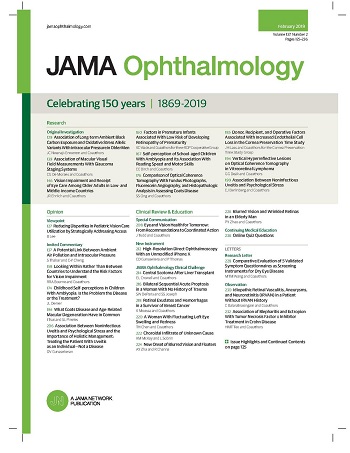Patient-Reported Importance of Functional Benefit in Geographic Atrophy.
IF 9.2
1区 医学
Q1 OPHTHALMOLOGY
引用次数: 0
Abstract
Importance Intravitreal complement inhibitors injections (IVCIs) slowed progression of geographic atrophy (GA) lesions in several registration phase 3 trials although without benefit for prespecified secondary functional vision outcomes. Patient acceptability of these therapies needs further exploration. Objective To quantify the acceptability of IVCI therapy to United Kingdom patients with GA, assuming vision outcome benefits are expected. Design, Setting, and Participants This cross-sectional study took place at 9 geographically dispersed UK National Health Service centers from April 2023 to April 2024 among 153 participants with treatment-naive GA in at least 1 eye. Exposures GA in at least 1 eye. Main Outcomes and Measures Main outcomes were (1) acceptability of IVCI therapy based on completion of validated acceptability questionnaire. Participants were provided with a treatment information leaflet coproduced by a patients with lived experience of GA to inform them about the risks and benefits of IVCI for GA, assuming there were vision outcome benefits to this treatment and (2) response to the EuroQol 5-dimension with a vision bolt-on questionnaire to assess general health and vision-related quality of life. Spearman rank correlations and χ2 tests were used to explore associations between acceptability levels and specific ocular and sociodemographic characteristics. Results A total of 153 participants were recruited (93 [60%] women; mean [SD] age, 82 [7]), 57 (38%) of whom had bilateral foveal involvement. Median (IQR) visual acuity with habitual correction in the better-seeing eye and in eyes where neither eye was better or worse was logMAR, 0.30 (0.14-0.54; approximate Snellen equivalent, 20/40) and 0.47 (0.14-0.84; approximate Snellen equivalent, 20/63), respectively. Among the 153 participants, 81 (53%; 95% CI, 45-61) reported IVCIs were very much or extremely acceptable under the theoretical scenarios provided. The proportion finding IVCIs acceptable rose to 82% (95% CI, 76-88) when including those who rated prospective treatment as moderately acceptable. Belief in the perceived effectiveness of the treatment (ρ, 0.52; 95% CI, 0.40-0.63; P < .001) and confidence in their ability to attend the eye clinic regularly (ρ, 0.51; 95% CI, 0.38-0.62; P < .001) correlated with overall acceptability. Conclusions and Relevance IVCI therapy for GA may be acceptable to most UK patients with GA under the assumption that there are vision outcome benefits to this treatment. While current treatments do not result in vision outcome benefits, perceived effectiveness by patients was associated with acceptability, emphasizing the desire to quantify vision functional benefit concomitant with anatomical slowing of progression.地理萎缩患者报告的功能益处的重要性。
玻璃体内补体抑制剂注射(IVCIs)在几个注册的3期试验中减缓了地理萎缩(GA)病变的进展,尽管对预先指定的次要功能性视力结果没有益处。患者对这些疗法的接受程度有待进一步探索。目的量化英国GA患者IVCI治疗的可接受性,假设视力结果有望改善。设计、环境和参与者本横断面研究于2023年4月至2024年4月在9个地理上分散的英国国家卫生服务中心进行,共有153名至少一只眼睛患有治疗期GA的参与者。至少一只眼睛接触到ga。主要结果和测量方法主要结果为:(1)通过填写经验证的可接受性问卷对IVCI治疗的可接受性进行评价。参与者被提供了一份由有GA生活经验的患者共同制作的治疗信息传单,告知他们IVCI治疗GA的风险和益处,假设这种治疗有视力结果的益处,(2)对EuroQol 5维度的反应和视力附加问卷,以评估一般健康和视力相关的生活质量。采用Spearman秩相关和χ2检验探讨可接受程度与特定的眼和社会人口学特征之间的关系。结果共纳入153例受试者,其中93例(60%)为女性,平均年龄82岁,57例(38%)为双侧中央凹受累。视力较好的眼和两眼均不较好的眼习惯性矫正后的中位视力(IQR)分别为logMAR, 0.30(0.14-0.54,近似Snellen等效,20/40)和0.47(0.14-0.84,近似Snellen等效,20/63)。在153名参与者中,81名(53%;95% CI, 45-61)报告在提供的理论方案下ivci非常或非常可接受。当包括那些将前瞻性治疗评为中等可接受的患者时,发现ivci可接受的比例上升至82% (95% CI, 76-88)。对感知治疗有效性的信心(ρ, 0.52; 95% CI, 0.40-0.63; P <。0.001)和对他们定期去眼科诊所的能力的信心(ρ, 0.51; 95% CI, 0.38-0.62; P < 0.001)。001)与总体可接受性相关。结论和相关性:在假设这种治疗对视力有好处的情况下,大多数英国GA患者可以接受eevci治疗。虽然目前的治疗方法没有带来视力结果的好处,但患者感知的有效性与可接受性有关,强调了量化视力功能益处的愿望,同时伴随着解剖上的进展减缓。
本文章由计算机程序翻译,如有差异,请以英文原文为准。
求助全文
约1分钟内获得全文
求助全文
来源期刊

JAMA ophthalmology
OPHTHALMOLOGY-
CiteScore
13.20
自引率
3.70%
发文量
340
期刊介绍:
JAMA Ophthalmology, with a rich history of continuous publication since 1869, stands as a distinguished international, peer-reviewed journal dedicated to ophthalmology and visual science. In 2019, the journal proudly commemorated 150 years of uninterrupted service to the field. As a member of the esteemed JAMA Network, a consortium renowned for its peer-reviewed general medical and specialty publications, JAMA Ophthalmology upholds the highest standards of excellence in disseminating cutting-edge research and insights. Join us in celebrating our legacy and advancing the frontiers of ophthalmology and visual science.
 求助内容:
求助内容: 应助结果提醒方式:
应助结果提醒方式:


